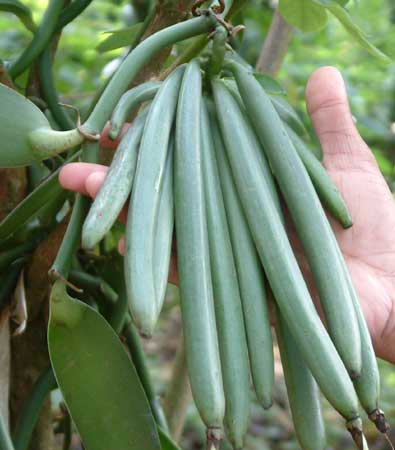 Natural vanillin is obtained from the cured pods (fruits) of the vanilla plant Vanilla planifolia (Family: Orchidaceae). Vanilla is a perennial climbing orchid with sessile leaves and succulent green stems, producing aerial roots (velamen roots) at the nodes. The important vanilla growing countries are Madagascar, Indonesia, Mexico, Comoro, and Reunion. Indonesia is the largest producer of vanilla in the world. Vanilla is a native of Mexico and was introduced to India as early as 1835. The estimated area under vanilla in India is about 1000 hectares with a production of 6-8 tonnes (1999-2000). Karnataka has the largest area under vanilla in the country.
Natural vanillin is obtained from the cured pods (fruits) of the vanilla plant Vanilla planifolia (Family: Orchidaceae). Vanilla is a perennial climbing orchid with sessile leaves and succulent green stems, producing aerial roots (velamen roots) at the nodes. The important vanilla growing countries are Madagascar, Indonesia, Mexico, Comoro, and Reunion. Indonesia is the largest producer of vanilla in the world. Vanilla is a native of Mexico and was introduced to India as early as 1835. The estimated area under vanilla in India is about 1000 hectares with a production of 6-8 tonnes (1999-2000). Karnataka has the largest area under vanilla in the country.
Natural vanillin is obtained from the cured pods (fruits) of the vanilla plant Vanilla planifolia (Family: Orchidaceae). Vanilla is a perennial climbing orchid with sessile leaves and succulent green stems, producing aerial roots (velamen roots) at the nodes. The important vanilla growing countries are Madagascar, Indonesia, Mexico, Comoro, and Reunion. Indonesia is the largest producer of vanilla in the world. Vanilla is a native of Mexico and was introduced to India as early as 1835. The estimated area under vanilla in India is about 1000 hectares with a production of 6-8 tonnes (1999-2000). Karnataka has the largest area under vanilla in the country.
There are three important cultivated species of vanilla namely, Vanilla planifolia (Mexican vanilla), V. Pompona (West Indian vanilla), and V. Tahitensis (Tahitian vanilla). V. Planifolia is predominantly cultivated for the production of vanillin. V. Tahitensis and V. Pompona also yield vanillin, apart from V. Planifolia, but of inferior quality.
Climate and soil
Vanilla is adapted to a wide range of soil types rich in humus and has good drainage. It thrives well in a humid tropical climate with an annual rainfall of 200-300 cm from sea level to 1500 m above sea level. A warm humid climate with temperature ranging from 21 to 32°C is ideal for the plant. The rainfall should be well distributed for a period of 9 months and there should be a dry period of 3 months for flowering. In India, parts of Kerala, Karnataka and Tamil Nadu, northeastern region and Andaman and Nicobar islands are suitable for vanilla cultivation. Clayey soils and waterlogged areas are not suitable for the plant.
Propagation
Vanilla is usually propagated by stem cuttings. Cuttings of 60-120 cm long can be selected as planting material for direct planting in the field. Cuttings less than 60 cm should not be used directly for planting. Such cuttings have to be rooted and raised in the nursery before planting. The stem cuttings after collection should be washed thoroughly and dipped in Bordeaux mixture 1% or copper oxychloride 0.2% for killing pathogenic fungi if any. Then the cuttings are stored in a cool shaded place for 2-3 days for the partial loss of moisture, a process which enhances rooting. The cuttings can also be stored up to 10 days if required. Plants raised from mature lengthy cuttings flower early. Tissue cultured plantlets can also be utilized for planting. However, sufficiently grown up plantlets should be used.